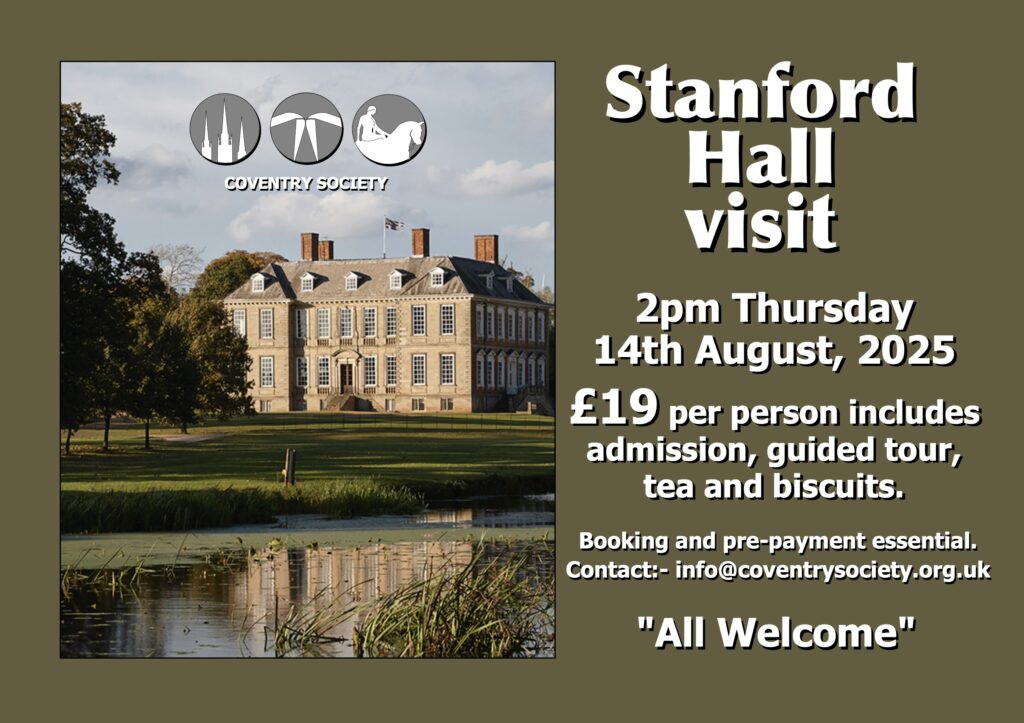
In August there is an opportunity to join the Coventry Society in a visit to Stanford Hall in Leicestershire.
Stanford Hall is a Grade 1 listed stately home. It was built in 1697 in the reign of William & Mary and is situated between the borders of the counties of Leicestershire, Northamptonshire and Warwickshire. The Hall is surrounded by 700 acres of private park and woodland.
The Cave family, direct ancestors of Nick and Lucy Fothergill the current owners, have been the custodians of the land for over 590 years, since 1430 and linked to the Braye peerage since 1839.
The History of the Estate
The history of the estate goes back to 1430. In that year the Cave family arrived from Yorkshire to farm the land as tenants of Selby Abbey in Yorkshire with Richard Cave as minister to St Nicholas Church at Stanford on Avon.
In 1540 Thomas Cave bought the land from Henry VIII following the dissolution of the monasteries.
In 1641 Sir Thomas Cave was created 1st Baronet by Charles 1st for his services to the Royalist Cause and four years later Sir Thomas Cave hosted the King to lunch before the battle of Naseby. He resisted a Parliamentary visitation after the battle to allow the retreating King to escape.
In 1671 Sir Roger Cave became 2nd Baronet and in 1697 he commissioned William Smith of Warwick to build the Hall but he died before moving in.
In 1703 Sir Thomas Cave, 3rd Baronet, married Margaret Verney through whom the Braye peerage descended and the couple lived at Stanford Hall.
The 5th Baronet, Sir Thomas Cave, commissioned William Smith of Warwick to build the Stable Courtyard in 1737. The hall was altered and a ballroom created in 1745. This was famous for its ceiling.
In 1792 the Reverend Sir Charles Cave becomes 8th Baronet, sat briefly as MP for Leicester and died childless with the Baronetcy moving away from Stanford to Sir William Cave-Browne-Cave, great grandson of the 2nd Baronet, who becomes 9th Baronet. The current 17th Baronet is Sir John Robert Charles Cave-Browne-Cave, born 1957 and still living in Canada.
In 1839 Sarah Otway-Cave, the 6th Baronet’s only daughter inherited Stanford Hall and became 3rd Baroness Braye, bringing the Braye peerage out of abeyance, granted by Queen Victoria. In 1842 she purchased the Royal House of Stuart Portrait Collection.
Adrian, who became the sixth Lord Braye, developed a hydroelectric plant on the river and introduced electricity to the Hall in 1898. The following year a naval friend of Adrian, Percy Pilcher, was killed in a flying accident in the park.
In 1952 Adrian died on the way to Queen Elizabeth II’s coronation and the estate was taken over by Thomas Adrian who became the 7th Lord Braye and in 1958, with the support and vision of his American wife, Dorothea formerly Donoghue, opened The Hall to the public for the first time.
In 1985, Penelope, their daughter, became 8th Baroness Braye, following the death of her father. She took over full responsibility for Stanford with her husband Lt. Col Edward Aubrey Fletcher, starting a significant programme of restoration.
In 2003 the estate passed to a cousin Nicholas Fothergill and he and his wife Lucy now run the estate.
The House of Stuart Portrait Collection
One of the most precious collections at the hall is known as the House of Stuart Portrait Collection. This includes an exceptional portrait of the Young Pretender, King Charles II and a miniature of Mary Queen of Scots. There is also a collection of other Stuart memorabilia.
The collection was purchased in 1842 by Sarah, Baroness Braye, who was wintering in Rome with her daughter Catherine.
The Hilditch Porcelain Tea-Ware Collection
This collection of porcelain tea ware is displayed in the Green Drawing Room and in the Crocodile Room in the Stables Courtyard. It was donated to the Hall in 2013 by Margaret Hewat who also wrote a comprehensive collectors guide in 2003. Hilditch & Son were manufacturers of earthenware and porcelain at Lane End in North Staffordshire from 1822-1830. The collection consists of a large number of tea sets. Many of their designs are typical of H&S and are printed in underglaze blue or in sepia with glaze on enamelled colours known as ‘clobbering’. These fine quality porcelain tea sets were a speciality in Victorian times and reflect the chinoiserie taste of the period. They are all marked in the famous ‘H&S’ markings.
The Percy Pilcher Aviation Collection
The Pilcher Aviation display is situated in the Stable Courtyard. Its principal exhibit is a working replica of ‘The Hawk’, the Flying Machine in which Lieutenant Percy Pilcher, RN, who is recognised as England’s Pioneer Aviator, was killed at Stanford in 1899.
The hall is normally only open to the public for two days a year, but the Coventry Society has organised a special visit to the hall on Thursday 14th August 2025 at 2 p.m.
The visit is limited to 20 participants, so let us know soon if you would like to join us. This is a paid visit which costs £19 per person, including admission, a guided tour of the hall and tea, coffee and biscuits. Booking and pre-payment is essential.
Please email mailto:info@coventrysociety.org.ukif you wish to join us.
